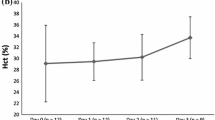Abstract
Maintaining the international normalized ratio (INR) within the therapeutic range in patients on oral anticoagulant treatment is a challenge for the physician. Excessive anticoagulation poses the risk of bleeding in patients. Management strategies vary among clinicians although standard guidelines exist for the same. We conducted an audit in patients on oral anticoagulant therapy in our hospital with excessive anticoagulation. This retrospective study was carried out among patients on oral anticoagulant therapy for various thrombotic conditions with at least a single INR recording of 5 or more. Other than demographic details, the type of oral anticoagulant used, indication, duration of treatment, dosage and concomitant use of interacting drugs or alcohol were also recorded. Detail of the nature and site of bleed and management for the same was also noted. Data were analyzed using descriptive statistics. Fifty episodes with INR ≥ 5 (5.0–10.75) were noted in 44 patients (M:F = 1:1). Their age ranged from 20 to 88 years (mean 50.3 ± 16.4 years). The duration of anticoagulant therapy varied from 3 days to 180 months. Of the 43 episodes in patients who had no bleeding, the anticoagulant was stopped on 32 occasions for variable periods with dose reduction in the rest of the patients. Spontaneous bleeding was seen in seven patients (6 major and 1 minor). Among the seven patients with bleeding, other than stopping he oral anticoagulant drug, other measures taken were vitamin K therapy, fresh frozen plasma or packed red cell transfusion. Overall management strategy of patients with high INR was in compliance with standard recommendations.



Similar content being viewed by others
References
Ansell JE (1993) Oral anticoagulant therapy—50 years later. Arch Intern Med 153:586–596
Landefeld CS, Beyth RJ (1993) Anticoagulant related bleeding: clinical epidemiology, prediction, and prevention. Am J Med 95:315–328
Cannegieter SC, Rosendaal FR, Wintzent AR, van der Meer FJ, Vandenbroucke JP, Briet E (1995) Optimal oral anticoagulant therapy in patients with mechanical heart valves. N Engl J Med 333:11–17
Lousberg TR, Witt DM, Beall DG, Carter BL, Malone DC (1998) Evaluation of excessive anticoagulation in a group model health maintenance organization. Arch Intern Med 158:528–534
Fihn SD, McDonnel M, Martin D, Henikoff J, Vernes D, Kent D et al (1993) Risk factors for compilations of chronic anticoagulation. A multicenter study. Warfarin optimised outpatient follow-up study group. Ann Intern Med 118:511–520
Ansell J, Hirsh J, Hylek E, Jacobson A, Crowther M, Palareti G (2008) Pharmacology and management of the vitamin K antagonists. American college of chest physicians. Evidence-based clinical practice guidelines, 8th edn. Chest 133:160S–198S
Devine EB, Hopefl AW, Wittkowsky AK (2009) Adhrence to guidelines for the management of excessive warfarin anticoagulation. J Thromb Thrombolysis 27:379–384
Bussey HI, Chiquette E, Bianco TM, Lowder-Bender K, Kraynak MA, Linn WD et al (1997) A statistical and clinical evaluation of fingerstick and routine laboratory prothrombin time measurements. Pharmacotherapy 17:861–866
Ansell J, Hirsh J, Dalen J, Bussey H, Anderson D, Poller L et al (2001) Managing oral anticoagulant therapy. Chest 119:22S–38S
Glover JJ, Morrill GB (1995) Conservative treatment of overanticoagulated patients. Chest 108:987–990
Brigden ML, Kay C, Le A, Graydon C, McLeod B (1998) Audit of the frequency and clinical response to excessive oral anticoagulation in an out-patient population. Am J Hematol 59:22–27
van der Meer FJ, Rosendaal FR, Vandenbroucke JP, Briët E (1993) Bleeding complications in oral anticoagulant therapy. An analysis of risk factors. Arch Intern Med 153:1557–1562
Hylek EM, Chang Y, Skates SJ, Hughes RA, Singer DE (2000) Prospective study of the outcomes of ambulatory patients with excessive warfarin anticoagulation. Arch Intern Med 160:1612–1617
Azar AJ, Cannegieter SC, Deckers JW, Briet E, van Bergen PF, Jonker JJ et al (1996) Optimal intensity of oral anticoagulant therapy after myocardial infarction. J Am Coll Cardiol 27:1349–1355
The European atrial fibrillation trial study group (1995) Optimal oral anticoagulant therapy in patients with nonrheumatic atrial fibrillation and recent cerebral ischemia. N Engl J Med 333:5–10
Murphy PT, Casey MC, Abrams K (1998) Audit of patients on oral anticoagulants with international normalized ratios of eight or above. Clin Lab Haem 20:253–257
Author information
Authors and Affiliations
Corresponding author
Rights and permissions
About this article
Cite this article
Chopra, S., Kakkar, N. An Audit of Management of Patients on Oral Anticoagulant Therapy With International Normalized Ratio (INR) Five or Above. Indian J Hematol Blood Transfus 29, 11–16 (2013). https://doi.org/10.1007/s12288-011-0137-4
Received:
Accepted:
Published:
Issue Date:
DOI: https://doi.org/10.1007/s12288-011-0137-4




